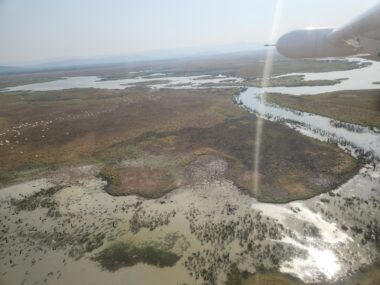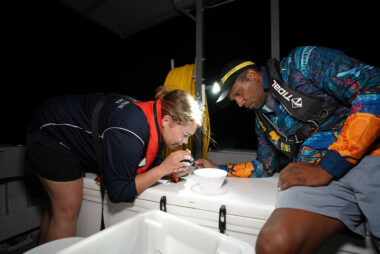Scientists show dingoes are deterred by the urine of male dingoes in their prime.
A study of the chemical makeup of dingo urine and how wild dingoes respond to it could assist scientists to develop non-lethal management tools, new research has found.
“The major finding of this study is that urine from an adult male dingo in his prime seems to have an immediate effect on dingoes who smell it in the wild,” says lead researcher and PhD student Ben Walker, from UNSW Sydney.
“Dingoes responded faster and more strongly to urine from prime-age males than to scent from dingoes that were younger or older than their prime. And the other effect we noticed was they didn’t really want to come back for two or three days.”
In the research carried out by UNSW, Taronga Conservation Society Australia and the Dingo Sanctuary and Research Centre and published recently in the journal Chemical Senses, Mr Walker and his colleagues described how they divided adult dingoes into three age groups: dingoes in their prime (aged five to nine years), and other adult dingoes that were either younger (three to five) or older (10+) than this.
Lyn Watson, manager of the Dingo Discovery Sanctuary and Research Centre in Toolern Vale, Victoria, collected 30 urine samples from 13 captive adult male dingoes to be analysed in the study.
“Getting the urine of dingoes is a unique skill,” Ms Watson says drily.
“But having spent 39 years working with dingoes and seeing how they respond to alpha dingo scent makes me very hopeful that a product will emerge from this which will help farmers.
“The territorial instinct of dingoes is even stronger than the breeding instinct, so this scent has meaning in the Australian landscape, mostly to other dingoes who will always respect the alpha male.”
After analysing the chemical composition of the urine, the researchers identified 107 chemical components in the samples. Of these, 33 chemical compounds were found to be ubiquitous among all dingoes, while no chemicals appeared exclusively in any age groups.
The idea behind analysing the chemical makeup was to narrow down the number of chemicals in the urine responsible for ‘signalling’ status or age to other dingoes and to see if dingoes responded differently to dingo urine on this basis. To do this, the team had to first freeze the urine, then transport it to the Strzelecki Desert, where they placed it at the base of posts and used remote camera-traps to watch how desert dingoes reacted to these smells.
Previous research carried out in 2015 had looked at the chemical composition of captive dingo urine, but this work was the first to test how wild dingoes responded.
“Combining chemical analysis with behavioural experiments in the wild is an unusual but crucial approach,” Mr Walker says.
“The logistics of bringing the samples in a fridge for two and a half days on a trip to the desert makes it a lot more difficult.”
When the team reviewed the footage, they noticed that the biggest responses were to urine from male dingoes in their prime. This suggests that the status of the dingo was communicated via the scent in the urine. What’s more, dingoes also seemed capable of determining how recently the scent had been deposited.
In a key plot twist, the researchers exposed collected samples to the elements for one, four, and 33 days before transporting them to the lab and desert for testing. They found that the potential status signals persisted chemically through a month of intense summer sun, but that dingoes responded more strongly to fresher scent.
Non-lethal management
Co-author on the paper Dr Neil Jordan, who has a conjoint position with UNSW and Taronga Conservation Society Australia, says the results suggest that “dingoes may be able to tell not just the age of the dingo that left the scent, but also how long ago that dingo was there”.
Dr Jordan’s work includes developing innovative non-lethal ways to protect livestock and predators such as painting eyes on the rumps of livestock in Africa to scare off would-be predators. He says that deterring dingoes from specific areas like livestock paddocks or campgrounds would be better than broadscale removal from the landscape.
“Dingoes have important ecological roles, provide economic benefits, and have significant cultural value particularly to Indigenous groups. Non-lethal tools that focus on localised deterrence of dingoes rather than their wholescale removal would be very valuable, and this study may be a small step in that direction.”
Mr Walker says getting a shortlist of key chemical components is a big step given the scientists were faced with thousands before they’d started the analysis.
“While this might not be the ultimate solution, it's part of a serious effort to work a bit more with animals and their ecology rather than against them,” he says.
Contact details:
Lachlan Gilbert
UNSW News & Content
t: +61 404 192 367


